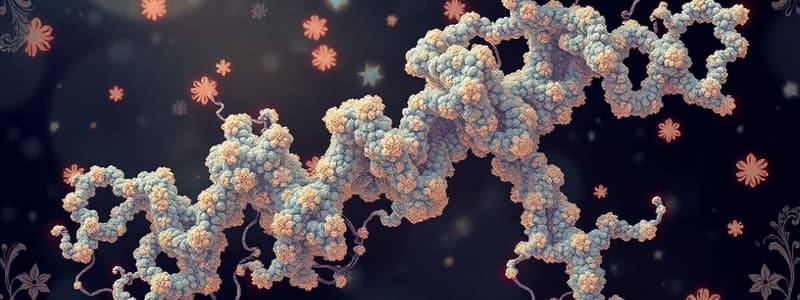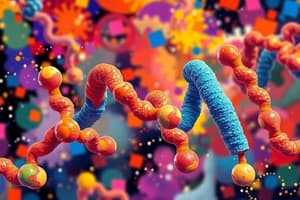Podcast
Questions and Answers
Which type of protein is made up of more than 50 amino acids?
Which type of protein is made up of more than 50 amino acids?
- Dipeptides
- Tripeptides
- Peptides
- Polypeptides (correct)
What is the primary role of proteins in cellular metabolism?
What is the primary role of proteins in cellular metabolism?
- Transport of nutrients
- Speed up chemical reactions (correct)
- Regulate cellular signaling
- Provide structural support
Which category of amino acids must be consumed in the diet?
Which category of amino acids must be consumed in the diet?
- Essential amino acids (correct)
- Nonessential amino acids
- Synthetic amino acids
- Conditional amino acids
What is the first step in protein synthesis?
What is the first step in protein synthesis?
How are amino acids characterized chemically?
How are amino acids characterized chemically?
Which type of protein is essential for intercellular signaling?
Which type of protein is essential for intercellular signaling?
A polypeptide is best defined as a chain of:
A polypeptide is best defined as a chain of:
What occurs after the mRNA attaches to the ribosome during protein synthesis?
What occurs after the mRNA attaches to the ribosome during protein synthesis?
What is the main structural function of microtubules in animal cells?
What is the main structural function of microtubules in animal cells?
What are centrioles primarily composed of?
What are centrioles primarily composed of?
What type of tension do intermediate filaments specifically resist?
What type of tension do intermediate filaments specifically resist?
What role does tRNA play in protein synthesis?
What role does tRNA play in protein synthesis?
How are actin filaments arranged in muscle cells?
How are actin filaments arranged in muscle cells?
Which statement best describes fibrous proteins?
Which statement best describes fibrous proteins?
Which protein is primarily involved in muscle contraction by interacting with actin?
Which protein is primarily involved in muscle contraction by interacting with actin?
What triggers muscle fatigue according to the content provided?
What triggers muscle fatigue according to the content provided?
What defines a protein domain?
What defines a protein domain?
What do antibodies primarily do?
What do antibodies primarily do?
Which of the following elements is NOT typically found in proteins?
Which of the following elements is NOT typically found in proteins?
What characteristic distinguishes microfilaments in terms of size compared to other cytoskeletal fibers?
What characteristic distinguishes microfilaments in terms of size compared to other cytoskeletal fibers?
Which of the following is a key characteristic of globular proteins?
Which of the following is a key characteristic of globular proteins?
What is a conjugated protein?
What is a conjugated protein?
What is the primary function of hemoglobin?
What is the primary function of hemoglobin?
What role do cilia serve in the respiratory system?
What role do cilia serve in the respiratory system?
What most likely precedes physiological fatigue in muscles?
What most likely precedes physiological fatigue in muscles?
Which condition is characterized by the absence of the protein dystrophin?
Which condition is characterized by the absence of the protein dystrophin?
What happens to muscle fibers during prolonged immobilization?
What happens to muscle fibers during prolonged immobilization?
What is a potential cause of motor protein defects like dynein deficiencies?
What is a potential cause of motor protein defects like dynein deficiencies?
Which disease is considered an amyloid disease affecting protein function?
Which disease is considered an amyloid disease affecting protein function?
What does the accumulation of misfolded proteins commonly lead to?
What does the accumulation of misfolded proteins commonly lead to?
Which of the following is NOT a type of fiber found in the cytoskeleton?
Which of the following is NOT a type of fiber found in the cytoskeleton?
What is a likely outcome of prolonged muscle disuse?
What is a likely outcome of prolonged muscle disuse?
What is the significance of disulfide bonds in protein structure?
What is the significance of disulfide bonds in protein structure?
How do proteins achieve their unique functions?
How do proteins achieve their unique functions?
What role do prosthetic groups play in proteins?
What role do prosthetic groups play in proteins?
What is feedback inhibition in enzymatic pathways?
What is feedback inhibition in enzymatic pathways?
What is allosteric regulation?
What is allosteric regulation?
Which of the following statements about ligands is true?
Which of the following statements about ligands is true?
How does positive feedback differ from negative feedback in enzymatic pathways?
How does positive feedback differ from negative feedback in enzymatic pathways?
What is the role of amino acid sequences in the folding of proteins?
What is the role of amino acid sequences in the folding of proteins?
Flashcards are hidden until you start studying
Study Notes
What are Proteins?
- Proteins are chains of amino acids, they are fundamental in almost everything an organism does.
Structure of Proteins
- Peptides contain fewer than 50 amino acids.
- Dipeptides have 2 amino acids.
- Tripeptides have 3 amino acids.
- Polypeptides have more than 10 amino acids.
- Proteins contain more than 50 amino acids.
- Typical protein chains have between 100 and 10,000 amino acids linked together.
- Amino acids are composed of carbon, hydrogen, oxygen, and nitrogen.
Essential, Nonessential, and Conditional Amino Acids
- Essential amino acids must be consumed in the diet.
- Nonessential amino acids can be synthesized by the body.
- Conditional amino acids cannot be synthesized due to illness or lack of necessary precursors.
Protein Synthesis
- mRNA copy is made of one of the DNA strands.
- mRNA copy moves out of the nucleus into the cytoplasm.
- tRNA molecules are activated as their complementary amino acids are attached to them.
- mRNA copy attaches to the small subunit of the ribosomes in the cytoplasm.
- A tRNA bonds complementarily with the mRNA via its anticodon.
- The ribosome moves along. The first tRNA leaves the ribosome.
- The process is repeated with 2nd and 3rd tRNA.
- Eventually, a stop codon is reached on the mRNA. The newly synthesized polypeptide leaves the ribosome.
Elements in a Protein
- Carbon, hydrogen, oxygen, nitrogen, and sulfur.
Protein Secretion
- Golgi bodies are numerous and active in secretory cells.
- Example secretory cells include gastric gland cells in stomach walls, pancreas.
- Proteins secreted by secretory cells include mucus, and insulin
Proteins & Their Function
- Proteins make up about 15% of the cell.
- Proteins in the cell have various functions.
- Enzymes regulate metabolism.
- Structural proteins provide support.
- Transport proteins help with movement and transport.
- Motor proteins are responsible for movement.
- Storage proteins store important nutrients.
- Signaling proteins carry signals between cells.
- Receptor proteins receive signals.
- Gene regulation proteins control gene expression.
- Special function proteins have unique roles.
Fibrous Proteins & Globular Proteins
- Fibrous proteins are several spiral-shaped polypeptide molecules linked in parallel by disulfide bridges.
- Globular proteins are several polypeptide chains folded roughly into a spherical shape.
Protein Domains
- A domain is a basic structural unit in a protein’s structure that can fold into a stable structure independently.
- Proteins can have one or many domains depending on their size.
Hemoglobin
- Hemoglobin is a conjugated protein.
- Hemoglobin has a globular protein called globin and a non-protein containing iron called heme.
- Hemoglobin has 2 alpha globin subunits and 2 beta globin subunits.
Protein Assemblies
- Proteins can form large assemblies.
- Proteins can form long chains if they have two binding sites.
- Actin fibers in muscles and the cytoskeleton are made from thousands of actin molecules.
- Cross-linkages can be between two parts of a protein or between two subunits.
- Disulfide bonds (S-S) form between adjacent -SH groups on the amino acid cysteine.
Protein Interactions
- The conformation of a protein gives it a unique function.
- Proteins interact with other molecules, usually one or a few molecules.
- Ligand is the molecule that a protein can bind to.
- The binding site is the part of the protein that interacts with the ligand.
Prosthetic Groups
- Prosthetic groups can enhance protein performance.
- Hemoglobin requires heme to carry oxygen.
- A prosthetic group required by an enzyme is called a co-enzyme.
- Co-enzymes help catalyze chemical reactions.
Regulation of Enzymes
- Feedback inhibition occurs when the end product of a metabolic pathway regulates the enzyme early in the pathway.
- Negative feedback is when the accumulation of the final product inhibits the pathway.
- Positive feedback occurs when a regulatory molecule stimulates the activity of the enzyme.
- Allostery is the conformational coupling of two widely separated binding sites where the active site recognizes the substrate, and the second site recognizes the regulatory molecule.
- An allosteric protein is a protein regulated by allostery.
- Allosteric regulation causes proteins to change their conformation after ligand binding.
Cytoskeleton and Motor Proteins
- Microtubules are hollow tubes made of tubulin protein in the cytoplasm of eukaryotic cells involved in the movement of organelles.
- Intermediate filaments are fibrous proteins that provide structural support for the cell.
- Microfilaments are made of actin protein and are involved in cell movement and shape.
- Microtubules resist compression, provide tracks for organelle movement, and play a role in cell division.
- Intermediate filaments are more permanent than microtubules or microfilaments and reinforce cell shape and fix organelle location.
- Microfilaments are involved in cell movement, cell division, and provide structural support.
Muscle Structure and Contraction
- Muscles use a sliding filament mechanism.
- Actin filaments and myosin filaments interact to cause muscle contraction.
- Calcium ions trigger the release of the myosin head binding sites on actin allowing the muscle to contract.
- The power stroke is the process of myosin heads pulling actin filaments closer together, causing the muscle to shorten.
- Cross-bridge cycling is the continuous process of myosin heads binding to and releasing from actin filaments, generating muscle contraction.
Muscle Fatigue
- Muscle fatigue occurs when the muscle can no longer generate or sustain the expected power output.
- It is thought to be caused by failure in excitation-contraction coupling within the muscle.
- Acidosis from lactic acid buildup may contribute to the sensation of fatigue perceived in the brain.
Muscle Disorders
- Muscle overuse can lead to fatigue and tears in the muscle tissue.
- Muscle disuse can lead to atrophy.
- Acquired disorders can be caused by infections, toxins, or injuries.
- Inherited disorders, such as muscular dystrophy, are often difficult to treat.
Duchenne Muscular Dystrophy
- Duchenne muscular dystrophy is caused by the absence of the cytoskeletal protein dystrophin.
- This leads to muscle fiber tears, calcium influx, and breakdown of muscle components.
Diseases Associated with Motor Protein Defects
- Dynein deficiencies can lead to respiratory tract infections due to cilia dysfunction.
- Defects in muscular myosin can cause myopathies and damaged muscle tissue.
Misfolded Proteins and Neurodegenerative Diseases
- Misfolded proteins can accumulate and cause disease.
- Amyloid diseases, such as Alzheimer's disease, Parkinson's disease, and Huntington's disease are caused by misfolded proteins.
Studying That Suits You
Use AI to generate personalized quizzes and flashcards to suit your learning preferences.




